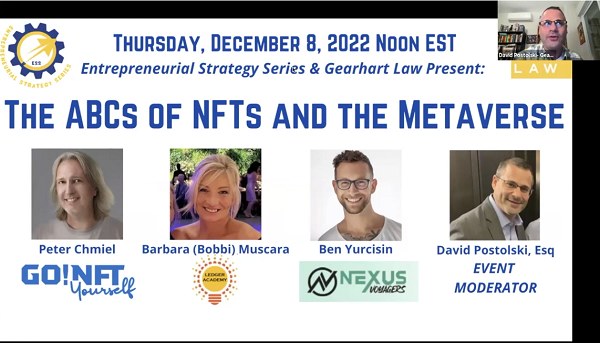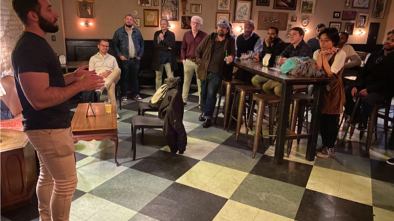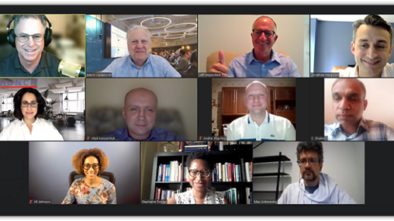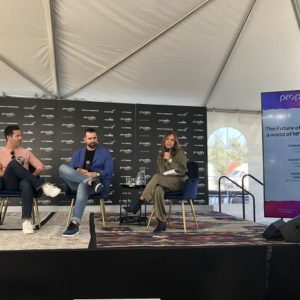Panelists Discuss the Ins and Outs of Non-Fungible Tokens and the Metaverse
It’s been a rough road for those who bought non-fungible tokens (NFTs) at sky-high prices last year. Not to mention for the software engineers and designers who have been laid off recently after working to design metaverse technologies.
Yet many industry observers believe that these digital universes and digital assets will outlast the current market problems, and once again be highly valued. In the meantime, this uneven economy may give new startups in these fields a head start on innovation in the space.
Recently, a virtual panel discussion on “the ABCs of NFTs and the Metaverse,” moderated by David Postolski, partner at Gearhart Law (Summit), featured a number of New Jersey experts on the subject.
The panelists discussed everything from how to get into the world of NFTs and the metaverse, how to avoid being a victim of bad actors once you are involved, and how NFTs and the metaverse will be good for business. They were all were optimistic about the future of these technologies.
The panel included:
- Peter Chmiel, founder and CEO of Go NFT Yourself (Sayreville), which enables artists or brands to sell NFTs to their entire fan base, not just to the crypto savvy.
- Barbara (Bobbi) Muscara, founder and director of education, Ledger Academy (Princeton), which is a blockchain-based learning center operating since 2016. Ledger Academy now hosts training experiences in the metaverse.
- Ben Yurcisin, founder of BeYu Labs (Jersey City) and the Nexus Voyagers Network, the latter a community of NFT entrepreneurs. He is a serial entrepreneur with a background in engineering and a passion for creating community through fun and value-packed events. He also organizes the Jersey City Tech Meetup.
What is the Metaverse? What are NFTs?
Up first was Muscara, who gave the audience a primer on how the metaverse and NFTs came to be. Every part of today’s metaverse was developed sometime in the ’80s or ’90s, she told the group. She said that we can currently transfer value “as cleanly as we can transfer information,” and that the metaverse is often used for commerce and company functions. For example, people purchase courses that she offers as NFTs. Many companies plan to do all their corporate hiring and employee training through the metaverse, she noted.
Chmiel brought the concept of NFTs down to its basics. “All it means is that this object is unique, it’s not interchangeable and it’s not divisible. That can be a digital or physical item, he said. “The NFT is a record of proof on the blockchain, that you own this unique item.”
He added, “This is like a title to a house or a ‘pink slip’ to your car, except on a public ledger where everyone can see it, so it’s transparent. And where this adds value, is now this gives creators [and] … anyone who has their own intellectual property” a way to “unlock the value of that intellectual property, creating a way to sell directly to their fans. And what’s a game changer is they can also get recurring revenues on secondary sales.”
With blockchain, NFTs automatically show proof of ownership of an item, and they automatically keep a record of how scarce the item is. “Having this proof of ownership, this certificate of authenticity, and knowing that [the item is] scarce is what has created this market now around NFT’s, and it’s how this technology enabled this explosion that occurred last year,” he said.
Buyer Beware
People buy NFTs through marketplaces like OpenSea, and once you purchase assets you can store them in a digital wallet or in an online wallet, the panelists explained. However, there are many issues that affect this process, and the industry is still having problems in creating ways to keep digital assets secure. For example, Muscara related a story about a marketplace she dealt with that had put hidden language in her agreement with them allowing them access to everything in her wallet. All her NFTs, which were primarily artwork, were stolen.
“I didn’t realize when I bid on the art ─ because, again, it wasn’t a tried-and-true website or an accurate place or a stable place ─ that when I agreed to hold money in escrow to see if I won that piece of art in the bidding process, I gave them permission to do anything with my wallet. Within a day of doing that, they had stolen all my NFT’s, and there was nothing anyone could do about it.” She reported it to the police, but there was really nothing that could be done, she said. So, it is a matter of “buyer beware” in NFT markets, she said.
Yurcisin agreed that it is “dangerous out there right now.” He said that any NFT collection that is about to launch with some hype will attract bad actors who copy the collection and offer fakes. And he urged collectors to go back to the communities they’ve been following and trace the links from those trusted resources. As for anything else, “don’t click it,” he warned. Muscara added that OpenSea verifies collections with a blue checkmark.
Another problem with the world of NFTs is that the technology is often too difficult for consumers to deal with, so it’s not a frictionless process. Chmiel noted that many are now asking how a billion people could be participating in the cryptocurrency market. But he thinks that, for NFTs, it’s all about applying the technology in such a way that “it just disappears into the background.” He said that one marketplace that’s doing this well is the NBA. And he has taken this model to heart.
Business Use Cases
NFTs will be important for business, Yurcisin said. “I believe that the second wave of NFTs will be business use cases. A few things to think about: first, supply chain. There are so many issues with supply chain logistics and tracking. This affects many web businesses. With the power of NFT’s, you can verify and track physical items that are backed by an NFT. So, from manufacturing, along the whole course of the lifecycle of a supply chain, you can actually see where it is and who holds and owns possession of that.”
Yurcisin pointed out that he had gone to an event and received a hoodie with a QR code on it. “And by getting the hoodie, I scanned the QR code and I minted an NFT that is a digital version of that hoodie. So, for example, if someone steals my sweatshirt and scans the QR code, they would be told, ‘You don’t hold this in your wallet, you’re not the true owner of this.’ And I know that’s just the hoodie and that’s just a silly example, but you could think about how that could tie into so many different things.”
Regulation
Near the end of the event, Postolski asked Muscara about government involvement in regulating blockchain technologies: Did she think they should be self-regulated by corporations or regulated by the government? Said Muscara, “I think this is a lot like cannabis. Nobody knows when this [market] is just going be electrified [take off]. The government itself is so far behind on regulations and doing guidelines, as seen by the FTX debacle. I mean, there were no guardrails. There were no guidelines for anyone in that scene.”
Chmiel added, “I think we need some smart regulation because what we’re seeing is they’re [state governments in the U.S.] forcing all these legal entities that are doing these projects [to go] overseas. And I’d rather see them stay here. But there needs to be a framework that’s clear to people, that protects people and makes it clear to the blockchain developers and smart contract developers what their liabilities are.”




